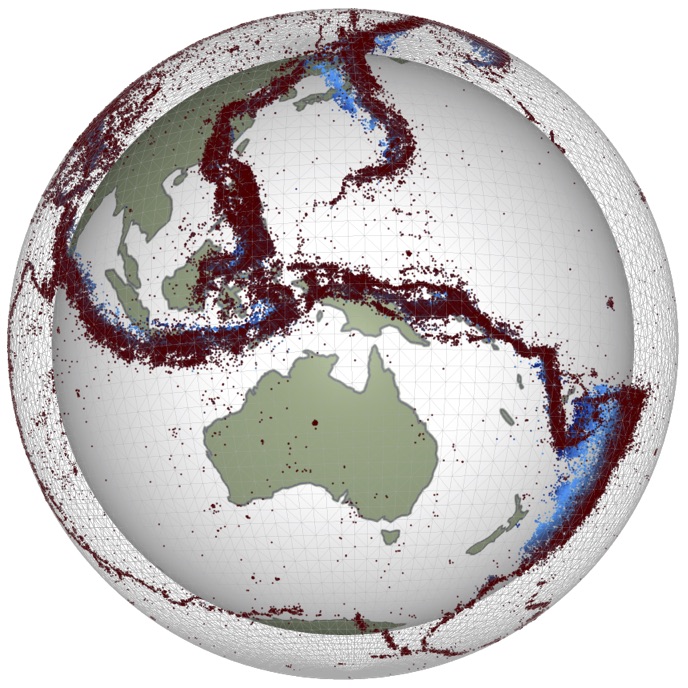Rayleigh-Taylor (Level-set based) in the sphere#
If there are just two materials, then an efficient way to manage the interface tracking is through a “level-set” which tracks not just the material type, but the distance to the interface. The distance is a continuous quantity that is not degraded quickly by classical advection schemes. A particle-based level set also has advantages because the smooth signed-distance quantity can be projected to the mesh more accurately than a sharp condition function.
# to fix trame issue
import nest_asyncio
nest_asyncio.apply()
import os
os.environ["UW_TIMING_ENABLE"] = "1"
import petsc4py
from petsc4py import PETSc
import underworld3 as uw
from underworld3.systems import Stokes
from underworld3 import function
from underworld3 import timing
import numpy as np
import sympy
render = True
lightIndex = 0
denseIndex = 1
viscosityRatio = 1.0
r_layer = 0.7
r_o = 1.0
r_i = 0.54
res = 0.25
Rayleigh = 1.0e6 / (r_o - r_i) ** 3
offset = 0.5 * res
cell_size = uw.options.getReal("mesh_cell_size", default=0.1)
particle_fill = uw.options.getInt("particle_fill", default=5)
viscosity_ratio = uw.options.getReal("rt_viscosity_ratio", default=1.0)
mesh = uw.meshing.SphericalShell(
radiusInner=r_i, radiusOuter=r_o, cellSize=res, qdegree=2
)
v_soln = uw.discretisation.MeshVariable(r"U", mesh, mesh.dim, degree=2)
p_soln = uw.discretisation.MeshVariable(r"P", mesh, 1, degree=1)
meshr = uw.discretisation.MeshVariable(r"r", mesh, 1, degree=1)
swarm = uw.swarm.Swarm(mesh=mesh)
material = uw.swarm.SwarmVariable(r"\cal{L}", swarm, proxy_degree=1, size=1)
swarm.populate(fill_param=2)
with swarm.access(material):
r = np.sqrt(
swarm.particle_coordinates.data[:, 0] ** 2
+ swarm.particle_coordinates.data[:, 1] ** 2
+ (swarm.particle_coordinates.data[:, 2] - offset) ** 2
)
material.data[:, 0] = r - r_layer
# Some useful coordinate stuff
x, y, z = mesh.CoordinateSystem.X
ra, l1, l2 = mesh.CoordinateSystem.xR
density = sympy.Piecewise((0.0, material.sym[0] < 0.0), (1.0, True))
display(density)
viscosity = sympy.Piecewise((1.0, material.sym[0] < 0.0), (1.0, True))
display(viscosity)
with swarm.access():
print(material.data.max(), material.data.min())
if False:
import numpy as np
import pyvista as pv
import vtk
pv.global_theme.background = "white"
pv.global_theme.window_size = [750, 750]
pv.global_theme.antialiasing = True
pv.global_theme.jupyter_backend = "panel"
pv.global_theme.smooth_shading = True
mesh.vtk("tmp_mesh.vtk")
pvmesh = pv.read("tmp_mesh.vtk")
with swarm.access():
points = np.zeros((swarm.data.shape[0], 3))
points[:, 0] = swarm.data[:, 0]
points[:, 1] = swarm.data[:, 1]
points[:, 2] = swarm.data[:, 2]
point_cloud = pv.PolyData(points)
with mesh.access():
pvmesh.point_data["M"] = uw.function.evaluate(material.sym[0], mesh.data)
pvmesh.point_data["rho"] = uw.function.evaluate(density, mesh.data)
pvmesh.point_data["visc"] = uw.function.evaluate(
sympy.log(viscosity), mesh.data
)
with swarm.access():
point_cloud.point_data["M"] = material.data.copy()
pl = pv.Plotter()
pl.add_mesh(pvmesh, "Black", "wireframe")
pl.add_points(
point_cloud,
cmap="coolwarm",
scalars="M",
render_points_as_spheres=True,
point_size=2,
opacity=0.5,
)
# pl.add_mesh(
# pvmesh,
# cmap="coolwarm",
# edge_color="Black",
# show_edges=True,
# scalars="M1",
# use_transparency=False,
# opacity=0.25,
# )
pl.show(cpos="xy")
stokes = uw.systems.Stokes(
mesh,
velocityField=v_soln,
pressureField=p_soln,
verbose=False,
solver_name="stokes",
)
# stokes.petsc_options.delValue("ksp_monitor") # We can flip the default behaviour at some point
stokes.petsc_options["snes_rtol"] = 1.0e-4
stokes.petsc_options["snes_rtol"] = 1.0e-3
stokes.petsc_options["ksp_monitor"] = None
stokes.constitutive_model = uw.constitutive_models.ViscousFlowModel
stokes.constitutive_model.Parameters.viscosity = viscosity
Gamma = mesh.Gamma
stokes.add_natural_bc(10000 * Gamma.dot(v_soln.sym) * Gamma, "Upper")
stokes.add_natural_bc(10000 * Gamma.dot(v_soln.sym) * Gamma, "Lower")
# buoyancy (magnitude)
buoyancy = Rayleigh * density # * (1 - surface_fn) * (1 - base_fn)
unit_vec_r = mesh.CoordinateSystem.X / mesh.CoordinateSystem.xR[0]
# Free slip condition by penalizing radial velocity at the surface (non-linear term)
stokes.bodyforce = -unit_vec_r * buoyancy
stokes.saddle_preconditioner = 1 / viscosity
mesh.CoordinateSystem.unit_e_0.shape
(mesh.CoordinateSystem.X / mesh.CoordinateSystem.xR[0]).shape
with mesh.access(meshr):
meshr.data[:, 0] = uw.function.evaluate(
sympy.sqrt(x**2 + y**2 + z**2), mesh.data, mesh.N
) # cf radius_fn which is 0->1
timing.reset()
timing.start()
stokes.solve(zero_init_guess=True)
timing.print_table()
# check the solution
if uw.mpi.size == 1 and render:
import pyvista as pv
import underworld3.visualisation as vis
pvmesh = vis.mesh_to_pv_mesh(mesh)
pvmesh.point_data["rho"] = vis.scalar_fn_to_pv_points(pvmesh, density)
pvmesh.point_data["M"] = vis.scalar_fn_to_pv_points(pvmesh, material.sym)
pvmesh.point_data["V"] = 10.0 * vis.vector_fn_to_pv_points(pvmesh, v_soln.sym)/vis.vector_fn_to_pv_points(pvmesh, v_soln.sym).max()
# point sources at cell centres
subsample = 2
cpoints = np.zeros((mesh._centroids[::subsample, 0].shape[0], 3))
cpoints[:, 0] = mesh._centroids[::subsample, 0]
cpoints[:, 1] = mesh._centroids[::subsample, 1]
cpoints[:, 2] = mesh._centroids[::subsample, 2]
cpoint_cloud = pv.PolyData(cpoints)
pvstream = pvmesh.streamlines_from_source(
cpoint_cloud,
vectors="V",
integrator_type=45,
integration_direction="both",
compute_vorticity=False,
surface_streamlines=False,
)
spoints = vis.swarm_to_pv_cloud(swarm)
spoint_cloud = pv.PolyData(spoints)
with swarm.access():
spoint_cloud.point_data["M"] = material.data[...]
contours = pvmesh.contour(isosurfaces=[0.0], scalars="M")
pl = pv.Plotter(window_size=(1000, 1000))
pl.add_mesh(pvmesh, "Black", "wireframe", opacity=0.5)
# pl.add_arrows(arrow_loc, velocity_field, mag=0.2/vmag, opacity=0.5)
pl.add_mesh(pvstream, opacity=1.0, cmap="RdGy_r",)
# pl.add_mesh(pvmesh, cmap="Blues_r", edge_color="Gray", show_edges=True, scalars="rho", opacity=0.25)
# pl.add_mesh(contours, opacity=1, color="Blue")
pl.add_points(spoint_cloud, cmap="Reds_r", scalars="M", render_points_as_spheres=True, point_size=10, opacity=0.3)
# pl.add_points(pdata)
pl.show(cpos="xz")
def plot_mesh(filename):
if uw.mpi.size != 1:
return
import pyvista as pv
import underworld3.visualisation as vis
pvmesh = vis.mesh_to_pv_mesh(mesh)
pvmesh.point_data["rho"] = vis.scalar_fn_to_pv_points(pvmesh, density)
pvmesh.point_data["M"] = vis.scalar_fn_to_pv_points(pvmesh, material.sym)
pvmesh.point_data["V"] = 10.0 * vis.vector_fn_to_pv_points(pvmesh, v_soln.sym)/vis.vector_fn_to_pv_points(pvmesh, v_soln.sym).max()
print(f"Vscale {vis.vector_fn_to_pv_points(pvmesh, v_soln.sym).max()}")
# point sources at cell centres
cpoints = np.zeros((mesh._centroids[::2].shape[0], 3))
cpoints[:, 0] = mesh._centroids[::2, 0]
cpoints[:, 1] = mesh._centroids[::2, 1]
cpoint_cloud = pv.PolyData(cpoints)
pvstream = pvmesh.streamlines_from_source(
cpoint_cloud,
vectors="V",
integrator_type=45,
integration_direction="both",
compute_vorticity=False,
surface_streamlines=False,
)
spoints = vis.swarm_to_pv_cloud(swarm)
spoint_cloud = pv.PolyData(spoints)
with swarm.access():
spoint_cloud.point_data["M"] = material.data[...]
contours = pvmesh.contour(isosurfaces=[0.0], scalars="M")
## Plotting into existing pl (memory leak in pyvista)
pl.clear()
pl.add_mesh(pvmesh, "Gray", "wireframe")
# pl.add_arrows(arrow_loc, velocity_field, mag=0.2/vmag, opacity=0.5)
pl.add_mesh(pvstream, opacity=0.33)
# pl.add_mesh(pvmesh, cmap="Blues_r", edge_color="Gray", show_edges=True, scalars="rho", opacity=0.25)
# pl.add_points(
# spoint_cloud, cmap="Reds_r", scalars="M", render_points_as_spheres=True, point_size=2, opacity=0.3
# )
pl.add_mesh(contours, opacity=0.75, color="Yellow")
# pl.remove_scalar_bar("Mat")
pl.remove_scalar_bar("V")
# pl.remove_scalar_bar("rho")
pl.camera_position = "xz"
pl.screenshot(
filename="{}.png".format(filename),
window_size=(1000, 1000),
return_img=False,
)
return
t_step = 0
# Update in time
expt_name = "output/swarm_rt_sph"
for step in range(0, 10):
stokes.solve(zero_init_guess=False)
delta_t = 2.0 * stokes.estimate_dt()
# update swarm / swarm variables
if uw.mpi.rank == 0:
print("Timestep {}, dt {}".format(t_step, delta_t))
# advect swarm
swarm.advection(v_soln.sym, delta_t)
if t_step < 10 or t_step % 5 == 0:
# plot_mesh(filename="{}_step_{}".format(expt_name, t_step))
mesh.petsc_save_checkpoint(index=t_step, meshVars=[v_soln], outputPath='./output/')
t_step += 1

